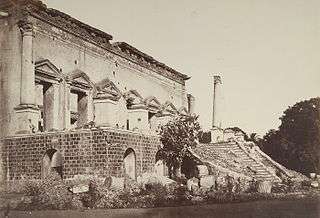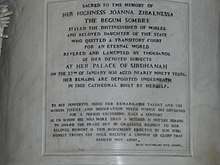Begum Samru
| Begum Samru | |
|---|---|
|
Portrait of Begum Samru | |
| Born |
Farzana Zeb-un-Nissa c. 1753 Kutana,[1] Meerut, India |
| Died |
27 January 1836 (aged 90) Sardhana, near Meerut, India |
| Burial place | Basilica of Our Lady of Graces, Sardhana |
| Other names | Joanna Nobilis Sombre |
| Occupation |
Nautch girl Ruler of Sardhana |
| Partner(s) | Walter Reinhardt Sombre |
Joanna Nobilis Sombre (ca 1753– 27 January 1836), a convert Catholic Christian,[2] popularly known as Begum Samru (Kashmiri: बेगम समरू (Devanagari), بیگم سمرو (Nastaleeq)) and also, as Begum Sumru,[3][4] (née Farzana Zeb un-Nissa) started her career as a Nautch (dancing) girl in 18th century India, and eventually became the ruler of Sardhana, a small principality near Meerut.[3] She was the head of a professionally trained mercenary army, inherited from her European mercenary husband, Walter Reinhardt Sombre.[3] This mercenary army consisted of Europeans and Indians. She is also regarded as the only Catholic ruler in India, as she ruled the Principality of Sardhana in 18th- and 19th-century India.[5][6]
Begum Sumru died immensely rich. Her inheritance was assessed as approximately 55.5 million gold marks in 1923 and 18 billion deutsch marks in 1953. Her inheritance continues to be disputed to this day.[7] An organisation named "Reinhards Erbengemeinschaft" still strives to resolve the inheritance issue.[8] During her lifetime she had converted to Christianity from Islam.[9]
Life

Begum Samru was of slight stature, fair complexion and distinguished by exceptional leadership abilities of an uncommon order. More than once, she headed her own troops in action. She was of Kashmiri descent.[10] When she was in her early teens, she married (or started living with) a mercenary soldier Walter Reinhardt Sombre of Luxembourg, who was operating in India. Walter Reinhardt Sombre, a European mercenary, then 45-years-old, came to the red light area and fell for the charms of Farzana, then a girl of 14, says Johan Lall in his "Begum Samru - Faded Portrait in a Gilded Frame".
A soldier of fortune, Sombre moved from Lucknow to Rohilkhand (near Bareilly), then to Agra, Deeg and Bharatpur and back to the Doab. Farzana helped him in those times of intrigue and counter-intrigue. Farzana was courted by some of the European officers who were associated with her husband. Among them were Le Vassoult, a Frenchman, and George Thomas, an Irishman. The Begum favoured the Frenchman and when, in 1793, the rumour spread that she had married him, her troops mutinied. The couple sought to escape secretly by night - Le Vassoult on horseback and the Begum in a palanquin. Misinformed that Le Vassoult had been shot, she stabbed herself but survived. Her lover, however, died of a self-inflicted wound to the head. One version has it that she suggested a suicide pact but only nicked herself when the unsuspecting Le Vassoult shot himself dead. When British General Lord Lake met the Begum in 1802, in a fit of enthusiasm he gave her a hearty kiss, which appalled her troops. But with her customary tact, Begum Samru pacified them by saying that it was only "the kiss of the Padre to a repentant child".[11]
The Begum, though only 4½ feet tall, wore a turban and rode on horseback as she led her troops to battle. So invincible did she seem that the superstitious spread the word that she was a witch who could destroy her enemies just by throwing her cloak towards them. Her army occupied the left of the Mahratta line at the battle of Assaye and hers was the only part of the Mahratta force that was not driven in disarray from the battle field. Having annihilated an advance by the 74th Highlanders and a picket detachment commanded by a Colonel Orrock, her army then withstood a cavalry charge from the Raj before marching from the field in good order. She inducted Jats into her irregular armies.[12][13]
Throughout her life, she had only one friend, Begum Umdaa, who belonged to the other Jagirdar Family of Sardhana became her closest friend with time and fulfilled her relation until her death with Begum Samru. Even after Begum Umdaa was married, Begum Samru took out time to visit her to Meerut in good and bad. On the death of her husband Walter Reinhardt, she succeeded to his Principality yielding about £90,000 per annum.
After the fall of Aligarh in September 1803, she was induced to surrender to Lord Lake and afterwards lived on good terms with the British, receiving visitors including the Bishop of Calcutta, Reginald Heber, Commander-in-Chief of the Indian Army Lord Combermere and Italian adventurer Jean-Baptiste Ventura.[11] Her conduct in the internal management of her estate was highly commendable. Over time, she became powerful, ruling over a large area from Sardhana, Uttar Pradesh. On 7 May 1781, aged around forty, Begum Samru was baptized Joanna Nobilis, by a Roman Catholic priest. She died at Sardhana in January 1837 at the age of 85, bequeathing the greater part of her property to David Ochterlony Dyce Sombre, who descended from Walter Reinhardt Sombre, from his first wife.[7] Several stories and novels have been written based on her political and diplomatic astuteness and on crucial battles fought by troops directly commanded by her.[14]
There is a rumor that One of the sons of the Begum had been killed by the Begum herself, as he had some physical disorder due to which he couldn't get married to any lady.
Palace at Sardhana and Chandni Chowk

The palace built by her in Sardhana near Meerut was the centre of much activity during the reign of Mughal Emperor, Akbar Shah. Shah Alam II, the predecessor and father of Akbar Shah, regarded Begum Samru as his daughter. He did so because the Begum had saved Delhi from an invasion by a force of 30,000 Sikhs, under Baghel Singh in 1783. They had encamped at Tis Hazari (the name of the place being derived from the number of those who constituted the force, estimated at 30,000). Thanks to the Begum's parleys, the Sikhs did not enter the city and went back to Punjab after getting a generous monetary gift from Shah Alam.
In 1787(?), when the emperor, Shah Alam, blind and feeble, was in pursuit of Najaf Quli Khan and trying to quell the rebellion stirred up by him, an incident occurred at Gokalgarh that brought the Begum closer to Shah Alam. Seeing that the emperor's troops were wavering in their resolve to attack the rebel leader, she advanced with a force of 100 men and whatever big guns she had and opened fire on Najaf Quli Khan and his men. This did the trick and Najaf sought the Begum's help to make his peace with Shah Alam. Thankful for her intervention, the emperor bestowed special honours on her at the royal court and declared her to be "his most beloved daughter". Not only that, she was also confirmed in her estate at Sardhana, which was the subject of a dispute with Louis Balthazar alias Nawab Zafaryab Khan, another son of her late husband, General Sombre, by his first wife, Badi Bibi (senior wife).Until his death, Emperor Shah Alam and his major wives treated her almost as a relative, and embraced her when she entered the zenana (women) quarters. as the English visitor Ann Deane noted in late December 1808: " ....and afterwards I accompanied her to the royal residence ......we then ascended ....to the zenanah ['women's quarters'].... the begum now led the way through crowds of eunuchs ....Here we were met by the queen Dowager....an ugly, shriveled old woman, whom the begum embraced."[15]
Begum Samru's palace in Chandni Chowk was built in a garden gifted by Akbar Shah, a later day mughal, to the Begum when he ascended the throne after the death of Shah Alam in 1806. Her palatial building still stands in Chandni Chowk, New Delhi. It is currently owned by the State Bank of India, Chandni Chowk Branch.[16]
Palace at Gurugram
Begum Samru Place at Gurugram lies between Badshahpur-Jharsa in Gurgaon. The paragana of Badshahpur-Jharsa was ruled by Begum Samru (b.1753 – d.1836) and she built a palace there for herself.[17] The palace has been lost to encroachments. Palace building is located between Gurgaon and Jharsa village, much of which was used as district collector's residence or camp office. Built in Islamic style, the ruins of this palace survived until about 2008 in Gurgaon.[18]
Death

Begum Samru died on 27 January 1836 at the age of 90 and was buried under the Basilica of Our Lady of Graces which she had built.
Popular culture
The Begum of Samru also features as a prominent character in the novel Flashman and the Cobra by Robert Brightwell.[19]
See also
Citations
- ↑ (ed.), Reina Pennington (2003). Amazons to fighter pilots. Westport, Conn. [u.a.]: Greenwood Press. p. 48. ISBN 9780313327070.
- ↑ "The Incredible Story Of Begum Samru". Retrieved 27 July 2018.
- 1 2 3

- ↑ Begum Sumru The Church of Basilica
- ↑ "The Sardhana Project".
- ↑ Sardhana Town The Imperial Gazetteer of India, 1909, v. 22, p. 105.
- 1 2 ""REINHARD'S ERBENGEMEINSCHAFT" R.E.G.: The Inheritance".
- ↑ ""REINHARD'S ERBENGEMEINSCHAFT" R.E.G.: Chronology of the Heir Community".
- ↑ The Indian Mutiny and the British Imagination by Gautam Chakravarty, Cambridge; ISBN 0-521-83274-8
- ↑ Dalrymple 2006, p. 238 "She was originally said to be a Kashmiri dancing girl named Farzana Zeb un-Nissa."
- 1 2 Blunt, Edward Arthur Henry (1911). List of Inscriptions on Christian Tombs and Tablets of Historical Interest in the United Provinces of Agra and Oudh. p. 16.
- ↑ Nonica Datta, "Forming an identity", The Tribune, 3 July 1999.
- ↑ Nonica Datta, 1999, "Forming an Identity: A Social History of the Jats, Oxford University Press, page 12.
- ↑ Profile Archived 1 April 2013 at the Wayback Machine., natgeotraveller.in; accessed 28 August 2014.
- ↑ Deane, Ann (1823). Tour Through the Upper Provinces in Hindostan. London: C and J.Rivington. pp. 148–175.
- ↑ Madhur Tankha. "History is bunk at this Delhi palace". Retrieved January 18, 2018.
- ↑ Begum Samru Palace, Gurugram, Haryana Tourism.
- ↑ "A queen's magnificent church". The Indian Express. 2 September 2012.
- ↑ "Flashman Rides Again". Telegraphindia.com. Retrieved 2015-09-01.
References
- Dalrymple, William (2006). The Last Mughal. Viking Penguin. ISBN 0-670-99925-3. .
- Keay, Julia (2014). Farzana: The Woman who Saved an Empire. I.B.Tauris. ISBN 978-1784530556. .
External links
| Wikimedia Commons has media related to Begum Samru. |